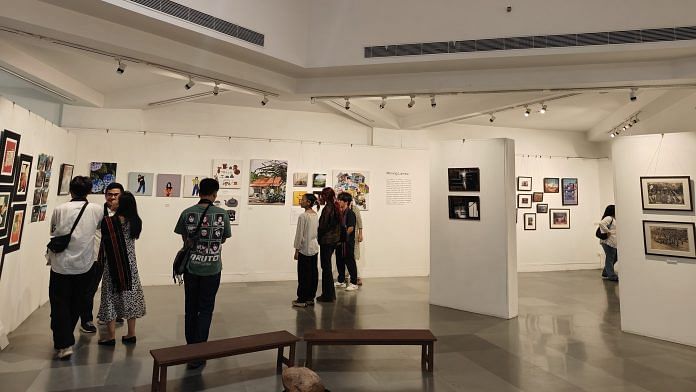New Delhi: A woven scarf, at least four feet long, unravels from the wall to the floor of the India International Centre art gallery in New Delhi. The patterns on the traditional puon keep changing to represent the nine Zo tribes of Lamka town in Manipur. It’s one of the central pieces of the exhibition, ‘Lengkhawm: Lamka Remembered’.
More than a year has passed since violence erupted between the Meitei people and Kuki-Zo tribes, resulting in more than 220 deaths and the displacement of nearly 50,000 people.
“The media showed the Kuki-Zo community in three ways — the victims, oppressors, or mere ‘artefacts’, different from other Indians. And the real essence and culture of the tribal people were lost,” said one of the organisers of the exhibition, John Simte, a lawyer from Delhi who left Lamka when he was an infant.
Lengkhawm: Lamka Remembered, which was curated by the collective ‘This is Lamka’, is an attempt to remind the rest of India of the rich heritage and history of the Zo tribal people in the town through vintage photographs, traditional installations, audio-visuals and modern art. The collective was set up in 2021, when Golan Naulak, a public policy professional from the town, proposed to curate a visual history of Lamka to the British Council. The Council approved the idea under the heritage grant for South Asia programme. He was joined by Lalson Ngaihte, creative director at an advertising agency who shared the same hometown with him. Slowly, they started visiting local houses, talking to local artists to put together the collection for the exhibition.
At the other end of a gallery, an eight-f00t long bamboo structure holds basic household items like a mattress, some clothes and food items packed in a bag, a heater, stool, mosquito net, and utensils. These mundane but essential items are an ode to displaced families.
The installation was an ode to the numerous families who had to leave their houses in Lamka due to the ethnic clashes.
“We want people to know that irrespective of what might be shown or told, we lead extremely normal lives. We are as ordinary as the rest of India,” added Simte.
Resonating with childhood
A group of college students stop to look at some of the black-and-white photographs. These are portraits of families eating together, models who won beauty pageants, local bands, young girls playing outside, marriage ceremonies, and even visits from famous people like actor Dev Anand and Prime Ministers Jawaharlal Nehru and Indira Gandhi.
They are part of the ‘Weaving Zo Memories’ section of the exhibition featuring archival photographs dating back to 1910 and sourced from the personal collection of families.
“It resonates with me, my childhood,” said Ponung from Arunachal Pradesh, who is enrolled in Ambedkar University. She listens to a folk song that was playing in the ground. “It has similarities with the folk songs that we sing back in my village,” she said.
The other section, ‘Lamka Dreaming’, has a more contemporary feel with colourful digital illustrations and videos that depict life in Lamka town. Viewers get a glimpse of the market, the women who sell vegetables, auto-rickshaws in the town, a Hollywood-inspired clothing market, food stalls—photographs of young men and women leaving their town for a better education and job opportunities in cities.
Jearyne identifies with this. She left Lamka when she was a child; her parents decided to relocate to Delhi. She last visited Lamka in 2019 before the Covid pandemic.
“We can’t go back there now because of the violence,” she said. “The old pictures of the fields, the markets, women dressed in traditional attires, children playing made me think of how life could have been if I grew up in Lamka. I miss the way how festivals are celebrated back in home town. We don’t get such elaborate celebrations here.”
Reimagining history
Jearyne Tinglalmuan Vaiphei volunteered to be a part of the immersive experience. It was her way of contributing to the tribal community amid the ongoing ethnic violence. Along with other members of the Zo tribes, she interacts with visitors, gives them tours and acts as a guide. She has the traditional ‘puan/puon’ draped over her denim skirt and shirt. She points to a black-and-white photograph of an old man taken by Hoijoukim Kongsai. It’s one of the exhibits in the Weaving Zo Memories, and next to it is a handwritten note stating the date and place where the picture was taken.
“My grandfather was a peace-loving man. It’s all the more relevant to remember him in these times,” said Kongsai.
Much of Lamka’s population was forced to flee their homes after the violence broke out. As he started watching the news and reading about the events unfolding in his state, Simte was drawn to his heritage. It’s after this that he started reading about his town’s history and art. He got in touch with young artists from Lamka as well as the collective to put together this exhibition.
According to Angus Guite, who was one of the artists whose photograph was on display, every piece of art is part of his cultural identity. Guite’s photographs are his dream for his hometown—a peaceful and thriving Lamka. And so, he chose a photograph from his series ‘I don’t want the news, I want the music,’ from before the violence.
“It is through my photographs that I can reimagine my town, my community, and my people,” he said.
(Edited by Humra Laeeq)



